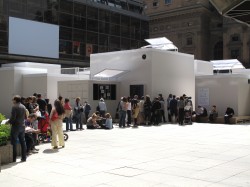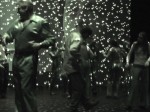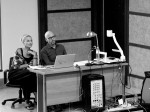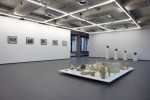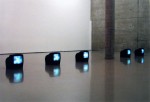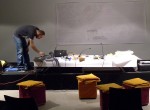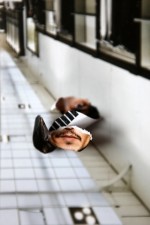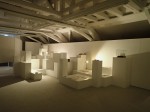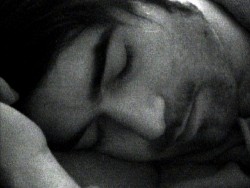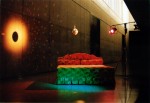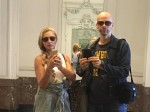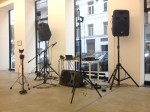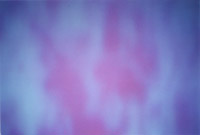
Eine Begrenzung, dazu angelegt Grenzen aufzulösen: Paul Divjaks Videoinstallation Journey besteht aus einem von drei Flächen umschlossenen Raum, zu dem man über eine sich drehende Schleuse Zutritt erhält. Auf jede der drei Flächen wird dasselbe bewegte Videobild projiziert, aus jeder der drei Ecken ertönt der Stereo-Sound von Hans Platzgumers gleichnamiger Komposition. Hier wurde, im Unterschied zu Benjamins Panorama, kein Ort des Sehens installiert, obwohl ebenso gleichviel gilt, bei welchem Bild man die Runde anfängt. Schon eher handelt es sich um einen Raum, der die Betrachter umschließt, sie in Ausführende der Installation verwandelt. Was bei Journey nämlich fehlt, ist präzise jener Ort, von dem aus die Direktionen und Dimensionen immer schon erschlossen sind, der es einem erlauben würde, sich ausschließlich auf sein Sehen zu verlassen und zwar auf allen denkbaren Ebenen: Es gibt weder einen privilegierten Blickpunkt (immer befindet ein Bild sich im Rücken der Betrachter), weder einen von den visuellen und akustischen Reizen geschaffenen Ort im Bild, an dem Ereignisse stattfinden, noch eine Narration, welche die Eindrücke zeitlich gewichtet. Das Ereignis ist vielmehr die Installation als Ganze, mit hin die konkrete Dauer des Verweilens in ihr. Nicht, dass es nichts zu sehen gäbe, sind die visuellen Daten dennoch hinreichend abstrahiert, so dass es wenig Sinn macht, auf ihrer Referentialität zu beharren (sicher kann man erkennen, dass das eine Flüssigkeit – Wasser? –, die gegen, ja wogegen eigentlich? – eine Mauer? eine Scheibe? –, schwappt, bloß: kommt es darauf wirklich an?
Wie auch in anderen Arbeiten von Divjak (I remember: turntable mix etwa, oder le matin) überwindet in Journey das Visuelle im Zusammenspiel mit dem Akustischen den Gegensatz zwischen dem Sichtbaren und dem Unsichtbaren: Ähnlich wie Benjamin vom Gedächtnis gesagt hat, dass es weniger ein Instrument für die Erkundung der Vergangenheit sei, sondern eher ein Medium, in dem diese aufscheinen könne, wäre auch Journey als Transportmittel zu begreifen, das den BetrachterInnen ihre eigenen Bilder entlockt, um sie in der Konfrontation mit den gegenwärtigen zu einer augenblicklichen Konstellation zu verschmelzen, von der nicht mehr mit Sicherheit angegeben werden kann, welchen Anteil an ihrem Zustandekommen das Sehen hält. Daher vielleicht auch das Schwanken, ob die Reise nun in die Ferne oder ins Eigene geführt haben wird. “Es war, als hätte ich noch eben Wind und Glocken hören können, wenn ich nur besser achtgegeben hätte.” (Walter Benjamin)
[Vrääth Öhner, Ausstellungskatalog: "Paul Divjak. Journey": in: Lebt und arbeitet in Wien. 26 Positionen aktueller Kunst, Kunsthalle Wien, 2000]
A creation of bounds designed to dissolve boundaries: Paul Divjak´s video installation Journey consists of a space enclosed by three surfaces to which one has access through a revolving sluice-gate. On each of the three surfaces the same moving video image is projected, from each of the three corners comes the stereo sound of Hans Platzgumer´s composition of the same name. Unlike Benjamin´s panorama, no place of seeing is installed here, even though it is still the case that it is of no account which image one begins with in order to go around. It is rather a space that encloses the observers, transforming them into performers of the installation. In fact, what is missing in Journey is the very place from where the directions and dimensions have always been opened up and which would enable one to depend purely on seeing – seeing on every level: there is neither a privileged point of view (at all times an image is behind the viewer), nor a place in the image created by the visual and acoustic stimuli where things happen, nor a narration that weights the impressions in terms of time. The event is rather the installation as a whole and, therefore, the concrete time spent dwelling in it. Not that there is nothing to see: the visual data are nonetheless sufficiently abstracted so that there is little sense in insisting on their referential character (one can certainly see that it´s a liquid – water? – lapping against, well, against what really? – a wall? a pane? – but is this what really matters?)
As in other video works by Divjak (I remember: turntable mix for example, or le matin) in Journey the visual co-operation with the acoustic overcomes the opposition between the visible and the invisible: Walter Benjamin said of memory that it is less an instrument for searching the past than the medium in which the past can appear – in a similiar way the whole of Journey may be seen as a means of transport that releases the viewer´s own images in order to merge them, in confrontation with the present images, in a momentary constellation, and there is no way to say with certainty to what extent this constellation has come about from seeing. This is perhaps the origin of the wavering as to whether the journey will have led to something distant or to what is our own: “it seemed as if I might just have heard wind and bells if only I had paid more attention.” (Walter Benjamin)
[Vrääth Öhner, Ausstellungskatalog: "Paul Divjak. Journey": in: Living and working in Vienna, Kunsthalle Wien, 2000]
